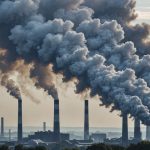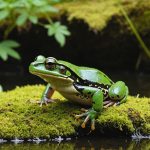Overview of Air Pollution and Avian Habitats
Air pollution refers to the release of harmful substances into the atmosphere, which can have significant impacts on various ecosystems. It’s often generated by industrial activities, vehicular emissions, and the burning of fossil fuels. These pollutants can cause harm not only to humans but also to avian habitats. Understanding the relationship between air pollution and avian diets is crucial for conservation efforts.
Avian habitats provide critical resources for bird populations, such as food, nesting sites, and protection from predators. Birds depend on these environments to thrive and maintain healthy populations. When air pollution occurs, it can affect these habitats by introducing toxins, altering vegetation, or reducing the availability of clean water and food resources.
En parallèle : Impact of UK Water Quality Regulations on Amphibian Breeding Habitats: An In-Depth Analysis
The health of bird populations is directly impacted by air pollution. For instance, toxic chemicals can contaminate the food supply, leading to health problems and reducing reproductive success in birds. Additionally, pollution can degrade the quality of avian habitats, making it challenging for birds to find suitable areas for living and breeding. Protecting avian habitats from environmental impact is essential to ensure the survival of diverse bird species and maintain ecological balance.
Current Research Initiatives in the UK
In recent years, the UK has emerged as a hub for pioneering research on air quality assessments and bird habitat studies. Several key initiatives are underway, aimed at understanding the multifaceted impact of industrial activities on environmental health.
En parallèle : Boosting Ground-Nesting Bird Conservation: The Role of Controlled Burns in the UK”s Heathlands
Across various governmental and academic platforms, significant efforts focus on air quality assessments. Researchers are employing advanced methodologies, like high-resolution atmospheric modelling, to evaluate the industrial impacts on air quality. This precision-driven approach enables them to predict pollution dispersion patterns and advise policymakers effectively.
Prominent studies, such as those led by the UK Environment Agency, delve into the consequences of emissions from industrial processes. These studies utilize diverse data sources, including satellite imagery and ground-level sensors, to yield comprehensive insights into pollution hotspots.
Equally important, bird habitat studies in the UK are leveraging innovative technologies. Researchers use GPS tracking and automated acoustic sensors to monitor avian populations, helping to understand how industrial development affects bird habitats.
These methodologies ensure precise analysis, offering scientific backing to conservation strategies and industrial regulation. As the UK continues to foster these research initiatives, it strengthens its role in global environmental stewardship, highlighting the indispensability of both air quality and biodiversity for sustainable development.
Case Studies of Affected Areas in the UK
In recent years, the UK has witnessed notable changes in its avian species populations, particularly in industrial areas. Through detailed case studies, we uncover the extent of the impact that pollution has on these regions.
In Wales, a study conducted near heavy industrial zones revealed a concerning decline in the number of sparrows and skylarks. These birds, once prevalent, are now scarce due to heightened pollution levels. Researchers found that increased concentrations of heavy metals in the environment, primarily from factory emissions, are substantially contributing to this decline, endangering these and other bird species.
In Scotland, another case study in oil refinery vicinities highlights shifts in avian communities over the past two decades. Notably, the diversity of bird species has diminished, with only a few resilient species adapting to the altered environments. This change underscores the profound influence of industrial activities on local wildlife.
These case studies not only provide us with ample information about the ecological impact but also press for urgent solutions. They serve as a stark reminder of the critical need for enhanced environmental regulations to protect these vulnerable avian populations and ensure the revitalisation of affected habitats.
Governmental and Non-Governmental Responses
Government policies and conservation efforts are essential for addressing issues such as air pollution and habitat degradation. Authorities globally have implemented various policy responses to tackle these concerns. Regulations on industrial emissions, promoting cleaner energy sources, and urban green space projects are initiatives for improving air quality management.
Governments often collaborate with Non-Governmental Organisations (NGOs) in monitoring and advocating for effective conservation strategies. NGOs play a crucial role in raising public awareness and engaging communities in sustainable practices. They also conduct vital research to track the health of bird habitats and provide policy recommendations.
Despite these efforts, the effectiveness of current strategies is mixed. Success varies significantly across regions, affected by factors such as political will, financial resources, and public support. For example, cities with stringent emissions standards often see significant improvements in air quality compared to those with lax regulations.
Ongoing challenges include balancing economic growth with environmental sustainability and ensuring consistent policy implementation. Innovative solutions and enhanced collaboration between governments and NGOs are necessary to overcome these obstacles and protect wildlife habitats effectively. Bridging policy gaps and improving air quality management remain imperative in the conservation efforts.
Future Directions and Recommendations
Understanding the future research landscape and implementing effective mitigation strategies is crucial to fostering sustainable environments. Present research gaps, particularly in the long-term impacts of pollutants, warrant thorough exploration. Identifying unknown variables and exploring future research methodologies can help create nuanced models for predicting air quality outcomes.
When it comes to policy recommendations, advancing air quality assessments is essential. By incorporating emerging technologies, policymakers can achieve more accurate and timely data analysis. Strategies such as deploying advanced sensors and leveraging AI can refine prediction models, ultimately leading to better-informed decisions. This approach will also assist in adapting measures that directly address industrial pollution, significantly reducing harmful emissions.
Preserving avian habitats within industrial settings is equally vital. Suggestions include implementing biodiversity corridors to promote movement and genetic flow among avian species. Enhancing protective measures, such as installing safe nesting structures, can mitigate the impact of industrial activities. Encouraging collaborative efforts among industry stakeholders, environmental agencies, and researchers fosters innovative solutions to these complex challenges. Ultimately, aligning future research initiatives and policy recommendations will facilitate a more harmonious coexistence between industrial progress and environmental preservation.











